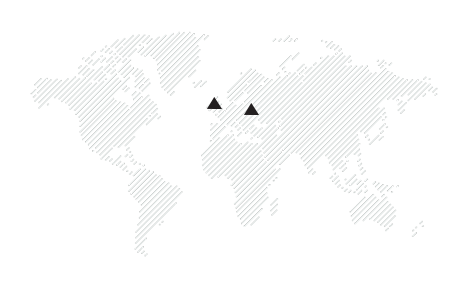This is the story of a remarkable man whose story is no less fascinating than that of Steven Jobs. In 50 years of leadership, he turned a little crucible printing machine factory by the train station in the city of Heidelberg into a huge thriving corporation.
There is very little information about him on the Internet, but this man can be called the Father of Printing without any doubt. Do you know who founded the DRUPA exhibition, which every self-respecting printer still considers necessary to visit? His name is Hubert Sternberg.
Of course, this man has his own history of ups and downs. For example, inspired by the success of letterpress machines, he moved to offset machines later than others. But better late than never. This man’s contribution to the printing industry is enormous, and without him we would definitely be at a different point of development.
Hubert H. A. Sternberg was born in Potsdam in 1897. He trained and worked as a businessman at the Mosse publishing house (Berliner Tageblatt), where he was already involved with printing presses.
In 1923, he moved to the Richard Kahn Group in Berlin, which also owned the Heidelberg high-speed press. In 1926, during the economic crisis, he joined the management board of the Heidelberg plant.
Thanks to Sternberg’s expertise, his sound judgement of the market and changes in production and distribution methods, the rapid press slowly began to rise. In 1937, Sternberg was appointed Chairman of the Management Board.

There was not a shadow of a doubt that Sternberg – attached to his home on the ‘Philosopher’s Alley’ on the slopes opposite the Old Town and the people of Heidelberg – actually belonged to his favourite company.
Sternberg died just a few months later, on 22 June 1987. But he will always be remembered as the Grand Old Man of the printing industry. The recipient of many honours and awards for his longstanding contribution to the German economy, he was already a legend in his own lifetime.
For 46 years he shaped the destiny of Heidelberg.
When the 76-year-old stepped down as Chairman of the Management Board at the end of 1972 and was appointed an honorary member of the Supervisory Board, he could look back on a lifetime of outstanding achievements.
An entrepreneur in the truest sense of the word, he had built Heidelberger Druckmaschinen from a small and insignificant company to become the world’s leading manufacturer of printing machines. The three pillars of the Sternberg corporate philosophy played a major role in this success: product, market and good business judgement.
His other strengths were his intuitive understanding of technical issues and his ability to infect others with his own enthusiasm. The ‘Heidelberg spirit’ he established united all employees, from the top director to the youngest intern, and helped the company through the most difficult times.

With this first fully automatic sheetfed printing machine, called ‘Tiegel’ in German, Sternberg laid the foundation for Heidelberg’s worldwide fame. The combination of cost-effective conveyor production and innovative marketing ideas enabled him to increase exports and turn the name ‘Heidelberg’ into a word of prestige, power and reliability for printers around the world.
Immediately after World War II, Sternberg contributed not only to rebuilding his own company, but also to reviving and strengthening the Heidelberg Chamber of Commerce and Industry. As its president between 1945 and 1949, he established links with the American occupation authorities, and in 1949 he organised the first German post-war exhibition in New York. During the years of shortages preceding the currency reform, Sternberg provided for his staff through the export initiative ‘Machines for Food.’

Among Sternberg’s most significant decisions in the 1950s was the construction of a new production site in Wiesloch, after plans to expand production in Heidelberg itself had been rejected. With his characteristic foresight, he made sure that there was plenty of space in reserve, without which Schnellpressenfabrik would not have been able to realise its ambitious investment plans for the next decade. The far-reaching consequences of this decision are still remembered to this day, not least because of the vocational school in Wiesloch that bears his name.
Due to the lack of space in Heidelberg, the new plant in Wiesloch was built in 1957, where the number of employees rose from 850 to 5000. The number of industrial trainees, who only came to Wiesloch in 1977, is around 340.
When Hubert H. A. Sternberg celebrated his 65th birthday in 1962, he was far from retiring and in fact remained at the helm of the company for another ten years. It was during this period that the company changed its name from Schnellpressenfabrik to Heidelberger Druckmaschinen AG to emphasise its technical achievements. Sternberg was an outstanding man who was not afraid to backtrack on his decisions. In 1961, for example, he agreed, despite some scepticism, to produce offset presses in addition to letterpress machines.

It was he who gave a decisive impetus to advertising aimed at exhibitors and visitors. And it was thanks to him that Düsseldorf was given a modern trade fair site in the early 1970s. Prior to Drupa 72, he chaired the exhibition committee and then served as its honorary president. Among the many honours and awards he received for his services to industry were the National Cross of Merit with Star (in which he was personally invested in 1962 by Ludwig Erhard, then Federal Minister for Economic Affairs) and an honorary degree as associate professor at the Aachen Polytechnic School (in 1967).
But the title that undoubtedly gave him the most pleasure was the title ‘Father of the Printers’, conferred on him by satisfied customers.
Based on materials (с) Heidelberg 1850-2000, PCS-Presse Service & Consulting GmbH, Munich, ISBN 3-00-006505-9 and HSS Wiesloch School
Also available onMedium.com


